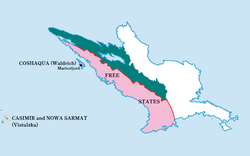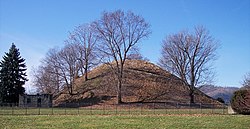Kahneska
This article is incomplete because it is pending further input from participants, or it is a work-in-progress by one author. Please comment on this article's talk page to share your input, comments and questions. Note: To contribute to this article, you may need to seek help from the author(s) of this page. |
Federated States of Kahneska 6 official languages
| |||||||||||||
|---|---|---|---|---|---|---|---|---|---|---|---|---|---|
|
Flag | |||||||||||||
| Anthem: Morning Song (Teehahnahmah)
| |||||||||||||
 Location of Kahneska in Elia Borealis | |||||||||||||
| Capital | Ahtawenhne | ||||||||||||
| Largest city | Nokosvyi | ||||||||||||
| Official languages | Gawonihisdi Kanien'kéha Iyuha Ínts’o Goyogohó twayaʔ | ||||||||||||
| Recognised regional languages | Helmenska Hyacinthean Fallish Waldish Helmish | ||||||||||||
| Ethnic groups (2022) | 26.7% Ama 17.7% Kanonhwarón 13.9% Škaŋkála 11.2% Wazha'ze 8.3% Gweñskë 6.6% Nihsëh 14.3% Elian/Free Stater 1.3% Other | ||||||||||||
| Religion (2022) | 58.1% Gregorianism 13.6% No religion 25.6% Folk religion 2.7% Other | ||||||||||||
| Demonym(s) | Kahneskan | ||||||||||||
| Government | Federal directorial parliamentary republic | ||||||||||||
| Ama Edohi | |||||||||||||
| Tekonwí Hill | |||||||||||||
| Waŋblí Ayútepiwiŋ | |||||||||||||
| Legislature | Kahneskan Parliament | ||||||||||||
| History | |||||||||||||
| Area | |||||||||||||
• Total | 448,454.7 km2 (173,149.3 sq mi) | ||||||||||||
• Water (%) | 9.53 | ||||||||||||
| Population | |||||||||||||
• 2022 estimate | |||||||||||||
• Density | 35.76/km2 (92.6/sq mi) | ||||||||||||
| GDP (PPP) | 2022 estimate | ||||||||||||
• Total | |||||||||||||
• Per capita | |||||||||||||
| GDP (nominal) | 2022 estimate | ||||||||||||
• Total | |||||||||||||
• Per capita | |||||||||||||
| Gini (2022) | low | ||||||||||||
| HDI (2022) | very high | ||||||||||||
| Currency | Uwoyí (Ꞹ), BSG) | ||||||||||||
| Time zone | UTC+4 (Kahneska Standard Time, KST) | ||||||||||||
| Date format | dd-mm-yyyy | ||||||||||||
| Driving side | right | ||||||||||||
| Calling code | +99 | ||||||||||||
| Internet TLD | .kn | ||||||||||||
Kahneska, officially the Federated States of Kahneska, is a sovereign state in Elia Borealis. It is bordered by the Free States to the west, the Siskiyou to the southeast, and X to the east. It is hydrologically bordered to the north by the Glacian Ocean and to the northwest by the North Medan Ocean. With an estimated population of around 16 million people, it ranks as the second most populous nation in Elia Borealis and is the most ethno-linguistically diverse. Kahneska's multiethnic heritage includes a mixture of indigenous Elian peoples and Calesian settler populations.
The territory of modern-day Kahneska hosted what was essentially the core of the Elian civilization, which extended across Elia Borealis; until the 16th century, after the disastrous Catabole crisis and Calesian colonization significantly shrunk the amount of land ruled over by the indigenous Elian tribes. Early forms of confederation persisted amongst the inland regions, where they often resisted colonial powers, until the early 18th century, with a brief resurgence again in the latter part of the century before being annexed into the Grand Federation in 1790. In the aftermath of a civil conflict alongside many decades of indigenous resistance, the country in its current borders gained its independence in 1895, taking on its current form of government in 1899. Since then, it has had some level of instability and internal strife, including internal tribal struggles and issues with the settler populations that still inhabit the country.
Known as the "land of lakes and mountains", Kahneska's abundance of biologically significant and unique ecosystems also includes many endemic species and landscapes and contributes to tourism and mineral exports as some of the primary means of economic development. However, despite being rich in raw exports, an estimated 22% of the population lives in poverty, nearly double that of its neighbors. Other issues facing the country include gun crime, corruption, and civil instability.
TBD
History
Pre-History
Around 10,000 BCE, some of the first Homo sapiens began to migrate westwards along a land bridge between Galania and Elia Australis. This era was marked too by a period of heightened global glaciation, cooler temperatures, and lower sea levels. Upon settling in Elia Australis for a couple thousand years, early humans began migrating northwards again.
As a result of early migration northwards from Elia Australis, the earliest human habitation of Elia Borealis began to occur around 3,000 to 2,500 BCE. The presence of humans in the region is evidenced by the existence of skeletal remains and stone tools found in the region. In particular, agricultural practices, likely carried over from Elia Australis; however, the majority of these cultures remained fairly nomadic or hunter-gatherer in nature.
Forest Period
The Forest period of Elia Borealis began around 200 CE, where agricultural practices became more widespread, and the nomadic and hunter-gatherer ways of life began to decline. It was also marked by the development of mound-building cultures, many of which settled down and started constructing small settlements centered around central mound structures. Many tribes began to develop agrarian and pastoralist practices in lieu of the aforementioned ones, and agricultural practices continued to develop and become widespread.
The decline of the Forest period came around 600 CE, where many cultures became largely sedentary, and advancements began to plateau for some time. Many archeological sites throughout the country also show how cultural practices and building styles were different between coastal, mountain, and planal parts of the continent.
Denvsoqua Period
After the Forest period of 200-600 CE came the Denvsoqua period, lasting from 800-1400 CE. The Denvsoqua period saw further advances in agriculture, the cultivation of maize, and the foundation of more complex chiefdoms, often consisting of several villages and concentrated populations. Much of the archeological findings today originate from this era, as it also saw unique cultural advances in pottery making, storytelling, and the use of sculptures and effigies, as well as unique burial practices.
Furthermore, the Denvsoqua period saw much of the sedentarization of the idnigenous groups as they appeared upon arrival by Calesian explorers. But the Catabolic crisis brought about the end of the Denvsoqua, as the cold temperatures and near-instantaneous climate change saw the Denvsoqua way of life torn asunder.


